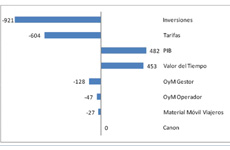
Categories
Publications
The unwanted effect of the predetermination of the fare on the costbenefit analysis of the new high-speed infrastructures
19/10/2015

Author/s: Alberto García Álvarez, Ignacio González Franco, Álvaro Rubio García
The fare applied to passengers has a very important influence on the economic-social and financial result of the construction of a high-speed line. In fact, it is the second most influential variable on the result following the quantity of the investment itself. This paper analyses the effects on the demand, revenue and results of fare changes. It is concluded that economic-social profitability almost always increases when fare is reduced, while financial profitability reaches a maximum with a determined fare value, over and under which lower values are reached. In the example case, two fares which are far from one another by 24% lead to the same financial result, while the economicsocial result achieved with the lowest of the two almost doubles that of the highest.
As a consequence, there is a reflection on the nature of the data being introduced in the costbenefit analyses. The paper goes on to highlight that there are some variables potentially manageable by the planner to which a determined nature should not be applied, but rather they should be object of optimization. Fare should not be given a stochastic treatment, since it cannot be a matter of chance. We have to find the fare that optimizes the desired result (usually the maximization of the economic-social benefit subject to a certain restriction on the financial result), and with that we would undoubtedly improve the balance for the society.
Related articles:
Keywords: Cost-benefit analysis, high speed, prices, fares, elasticity, price regulation.
Publication: 360.high speed magazine Nº 3 - October 2015, pág. 3-18
Download paper »



